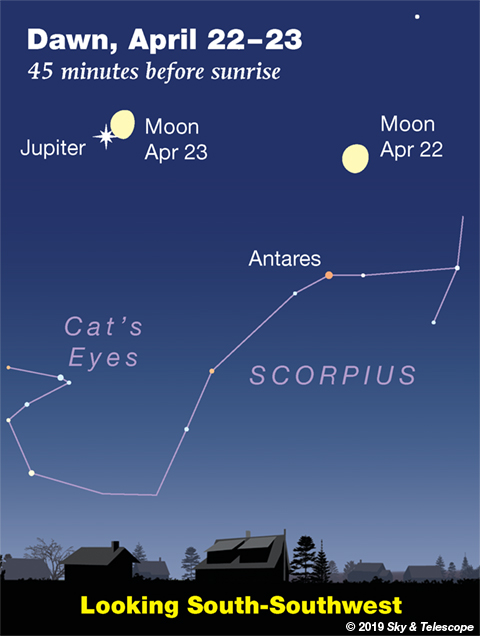
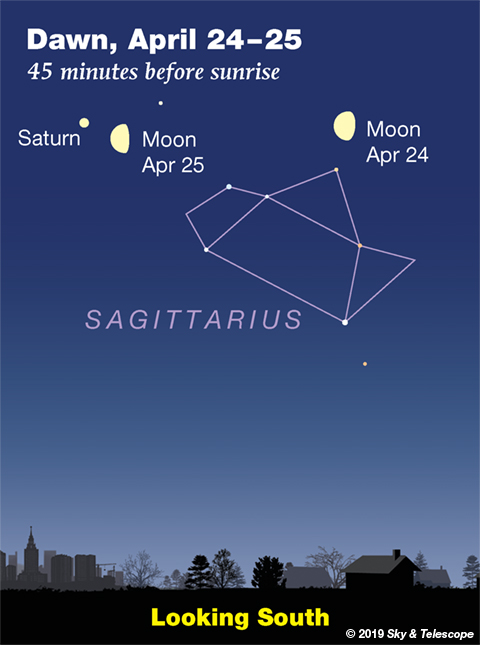
Friday, April 19
• Full Moon (exact at 7:12 a.m. Eastern Daylight Time). This evening look for Spica upper right of the Moon by about a fist and a half at arm's length, and brighter Arcturus about twice that far to the Moon's upper left.
Saturday, April 20
• About an hour after dark this week, the Pointer stars forming the end of the Big Dipper's bowl point straight down toward Polaris. Face north and look way up. Polaris is about three fists at arm's length from the Pointers.
Sunday, April 21
• Arcturus shines brightly in the east early these April evenings. The Big Dipper, very high in the northeast, points its curving handle to the lower right more or less toward it.
Arcturus forms the pointy end of a long, narrow kite asterism formed by the brightest stars of Bootes, the Cowherd. The kite is currently lying on its side to Arcturus's left. The head of the kite, at the far left, is bent slightly upward. The kite is 23° long, about two fists at arm's length. Look soon after dark before the Moon rises.
Monday, April 22
• The Lyrid meteor shower, usually weak to begin with, will be largely spoiled by bright moonlight during the shower's early-morning active hours tonight and tomorrow night.
• However, if you are outside in the hours before dawn Tuesday, you'll find Jupiter just a degree or two from the waning gibbous Moon (as seen from the longitudes of the Americas). Jupiter is currently 1,800 times more distant than the Moon — which it why it looks like just a dot even though it's 40 times larger in diameter.
Tuesday, April 23
• Right after dark, the Sickle of Leo stands vertical high in the south. Its bottom star is Regulus, the brightest of Leo. Leo himself is walking horizontally westward. The Sickle forms his front leg, chest, mane, and part of his head. Denebola, about two and a half fists left of Regulus, is his tail-tip.
• As dawn begins to brighten on Wednesday morning, the waning gibbous Moon shines almost midway between Jupiter to its right and Saturn to its left.
Wednesday, April 24
• As dawn begins on Thursday morning, the waning Moon poses with Saturn.
Thursday, April 25
• Right after dark, find Procyon high over bright Sirius in the southwest. Look upper left of Procyon by 15° (about a fist and a half at arm's length) for the dim head of Hydra, the enormous Sea Serpent. His head is a group of 3rd- and 4th- magnitude stars about the size of your thumb at arm's length.
About a fist and a half lower left of Hydra's head shines Alphard, his 2nd-magnitude, orange heart. The rest of Hydra zigzags (faintly) from Alphard far lower left almost to the southeast horizon.
• With the Moon now gone from the evening sky, explore the Leo Triplet and others of the best springtime galaxies with your sky atlas and the Deep-Sky Wonders column in the April Sky & Telescope, page 54.
Friday, April 26
• Last-quarter Moon (exact at 6:18 p.m. EDT). The Moon rises tonight around 3 a.m. daylight-saving time, right in the center of the dim, boat-shape pattern of Capricornus. High above it is Altair. The brightest "stars" far to the Moon's right or upper right are Saturn, then brighter Jupiter.
Saturday, April 27
• As the last of twilight fades out, the dim Little Dipper extends to the right from Polaris. High above the Little Dipper's bowl (marked by Kochab, Polaris's equal in brightness), you'll find the bowl of the Big Dipper.
________________________
Want to become a better astronomer? Learn your way around the constellations. They're the key to locating everything fainter and deeper to hunt with binoculars or a telescope.
This is an outdoor nature hobby. For an easy-to-use constellation guide covering the whole evening sky, use the big monthly map in the center of each issue of Sky & Telescope, the essential guide to astronomy.

Once you get a telescope, to put it to good use you'll need a detailed, large-scale sky atlas (set of charts). The basic standard is the Pocket Sky Atlas (in either the original or Jumbo Edition), which shows stars to magnitude 7.6.
Next up is the larger and deeper Sky Atlas 2000.0, plotting stars to magnitude 8.5; nearly three times as many. The next up, once you know your way around, are the even larger Interstellarum atlas (stars to magnitude 9.5) and Uranometria 2000.0 (stars to magnitude 9.75). And read how to use sky charts with a telescope.
You'll also want a good deep-sky guidebook, such as Sue French's Deep-Sky Wonders collection (which includes its own charts), Sky Atlas 2000.0 Companion by Strong and Sinnott, or the bigger Night Sky Observer's Guide by Kepple and Sanner.
Can a computerized telescope replace charts? Not for beginners, I don't think, and not on mounts and tripods that are less than top-quality mechanically (meaning heavy and expensive). And as Terence Dickinson and Alan Dyer say in their Backyard Astronomer's Guide, "A full appreciation of the universe cannot come without developing the skills to find things in the sky and understanding how the sky works. This knowledge comes only by spending time under the stars with star maps in hand."
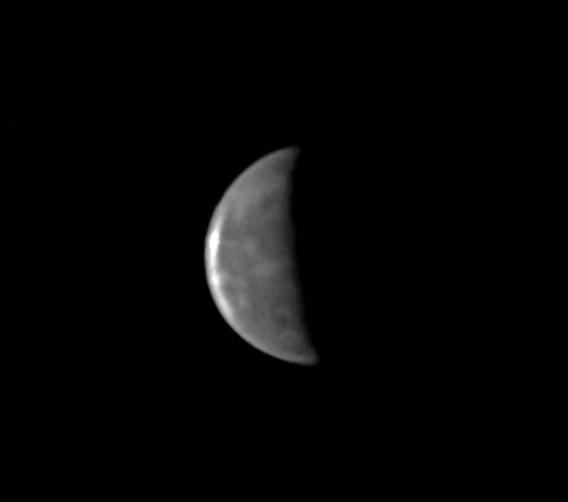
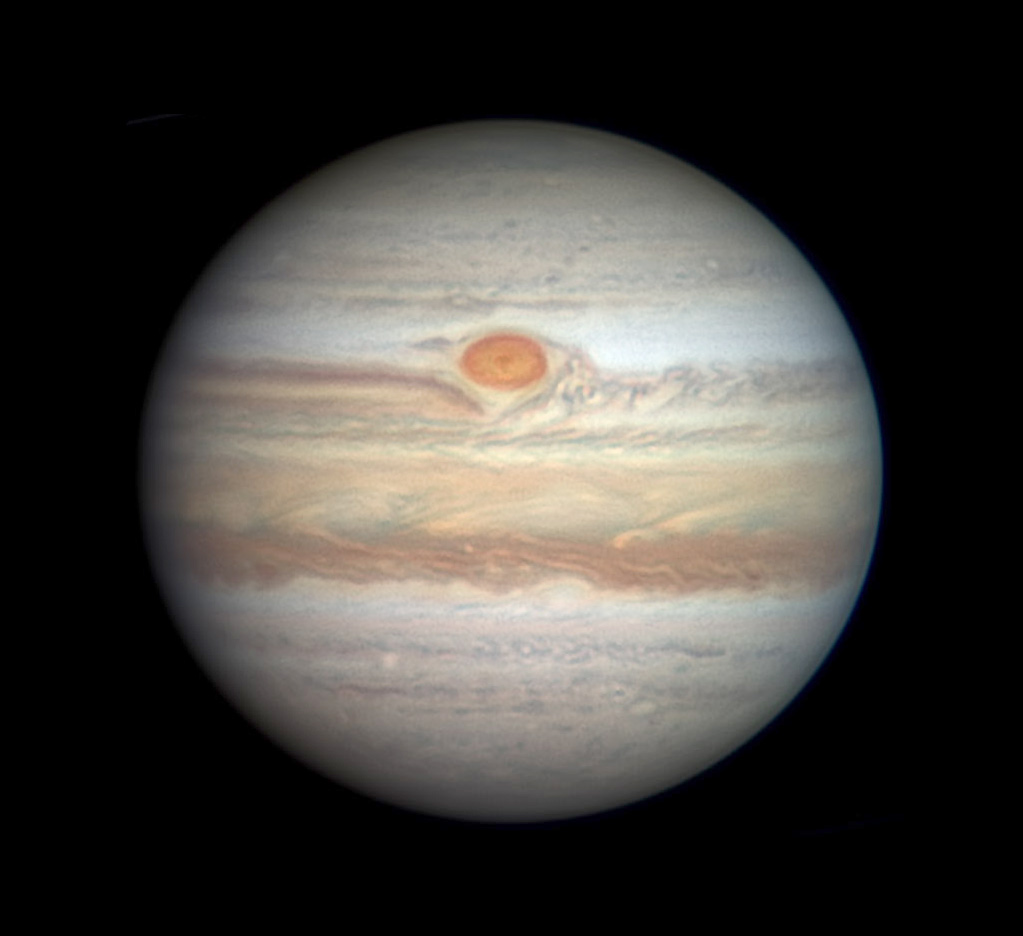
As I usually do, I've brightened Go's image to look a bit more like Jupiter does in a telescope. To mimic Jupiter's appearance in amateur scopes of various sizes (in very steady seeing), turn your screen to maximum brightness and view this image from the far side of the room while squinting your eyes to various degrees. Study the view as carefully as you can; take your time. What are the very finest details you detect that turn out to be real when you come close to check?
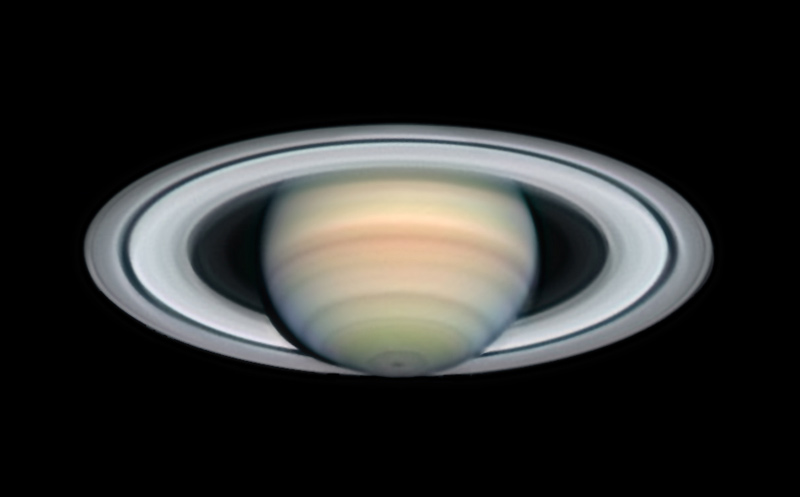
The Venus-Mercury challenge gets even tougher! Venus (magnitude –3.9) and much fainter Mercury (about magnitude –0.3) are both very low in the brightening dawn. Pick up Venus just above the due-east horizon about 20 minutes before sunrise. Then use binoculars or a wide-field telescope to look for little Mercury a good 6° to 8° to its lower left. Good luck.
Mars (magnitude +1.6, in Taurus) glows in the west after dusk, lower every week now. Spot it about 20° to the right of brighter, Mars-colored Betelgeuse – the topmost bright star of Orion on its way down.
More or less under Mars is Aldebaran, similarly orange. Above Mars, and matching it in brightness, is white Beta Tauri (Elnath). Mars crosses the line between these two stars on April 26th.
Jupiter (magnitude –2.4, at the eastern foot of Ophiuchus) rises in the southeast around midnight daylight-saving time. It shines fairly high in the south before the beginning of dawn, so that's the best time to observe it telescopically.
Saturn (magnitude +0.6, in Sagittarius) is the "star" 26° to Jupiter's left or lower left before dawn.
Uranus is hidden in its conjunction with the Sun.
Neptune is out of sight in the glow of sunrise.
______________________
All descriptions that relate to your horizon — including the words up, down, right, and left — are written for the world's mid-northern latitudes. Descriptions that also depend on longitude (mainly Moon positions) are for North America.
Eastern Daylight Time (EDT) is Universal Time (UT, UTC, or GMT) minus 4 hours.
______________________
Audio sky tour. Out under the evening sky with your earbuds in place, listen to Kelly Beatty's monthly podcast tour of the heavens above. It's free.
______________________
"I seem to have been only like a boy playing on the seashore, and diverting myself in now and then finding a smoother pebble or a prettier shell than ordinary, whilst the great ocean of truth lay all undiscovered before me."
— Isaac Newton, 1642–1727
______________________
 3
3
Comments
Rod
April 22, 2019 at 2:47 pm
mary beth, not good viewing for me lately (plenty of clouds) but early tomorrow morning may be good. Jupiter and the waning gibbous Moon will be about 1.5 degrees apart near 0510-0530 EDT on 23-April. South sky and Jupiter near 27-28 degrees altitude for me, higher for your area in Houston. Ophiuchus constellation, Jupiter is retrograding. I plan to view with my telescope using low power and wide field-will try and fit both into the eyepiece field of view at about 25x-31x views.
You must be logged in to post a comment.
Rod
April 23, 2019 at 7:24 am
mary beth, did you see Jupiter and the waning gibbous Moon this morning? I had very clear skies and enjoyed using my telescope. At 31x, I could fit the Moon, Jupiter, and 4 Galilean moons in the field of view. Part of Tycho crater area, lunar limb, and Jupiter visible with north and south equatorial cloud belts. Jupiter and the Moon were close to 1.5 degrees or less angular separation. Time was 0500-0545 EDT. Sunrise at my location near 0619 EDT. Jupiter retrograding in Ophiuchus.
You must be logged in to post a comment.
mary beth
April 24, 2019 at 11:35 pm
Hi Rod I’m glad it cleared up for you to see that beautiful scene of Jupiter and the moon! I did not get up in time to see it. We should be having clear skies for the next few nights starting tomorrow, it rained this evening. I was thrilled to see Antares and Jupiter a few late nights ago. Summer is fast approaching!
You must be logged in to post a comment.
You must be logged in to post a comment.